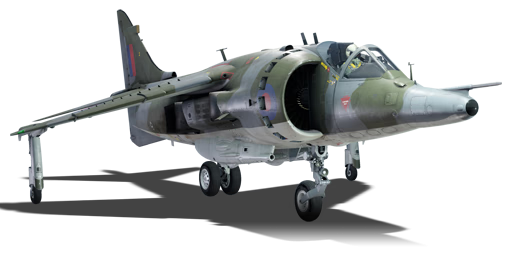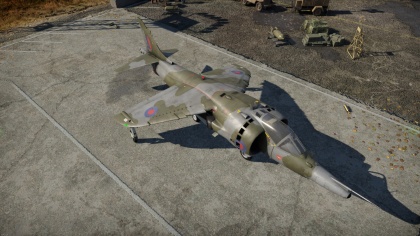Harrier GR.3
Contents
| This page is about the British jet fighter Harrier GR.3. For other versions, see Harrier (Family). |
Description
The Harrier GR.3 is a rank VI British jet fighter
with a battle rating of 10.3 (AB), 9.7 (RB), and 9.3 (SB). It was introduced in Update "New Power".
General info
Flight performance
Describe how the aircraft behaves in the air. Speed, manoeuvrability, acceleration and allowable loads - these are the most important characteristics of the vehicle.
| Characteristics | Max Speed (km/h at 0 m - sea level) |
Max altitude (metres) |
Turn time (seconds) |
Rate of climb (metres/second) |
Take-off run (metres) | |||
|---|---|---|---|---|---|---|---|---|
| AB | RB | AB | RB | AB | RB | |||
| Stock | 1,150 | 1,144 | 12192 | 32.5 | 33.7 | 69.5 | 67.8 | 550 |
| Upgraded | ___ | ___ | __._ | __._ | __._ | __._ | ||
Details
| Features | |||||
|---|---|---|---|---|---|
| Combat flaps | Take-off flaps | Landing flaps | Air brakes | Arrestor gear | Drogue chute |
| X | ✓ | ✓ | ✓ | X | X |
| Limits | ||||||
|---|---|---|---|---|---|---|
| Wings (km/h) | Gear (km/h) | Flaps (km/h) | Max Static G | |||
| Combat | Take-off | Landing | + | - | ||
| 1191 | 648 | N/A | 833 | 556 | ~14 | ~6 |
| Optimal velocities (km/h) | |||
|---|---|---|---|
| Ailerons | Rudder | Elevators | Radiator |
| < 648 | < 950 | < 790 | N/A |
Survivability and armour
The Harrier GR.1 has no armour. The engine and all fuel tanks are packed in a tight cluster in the centre of the fuselage.
Armaments
Offensive armament
The Harrier GR.3 is armed with:
- 2 x 30 mm ADEN Mk.4 cannons, belly-mounted (200 rpg = 400 total)
Suspended armament
The Harrier GR.3 can be outfitted with the following ordnance:
- Without load
- 5 x 500 lb H.E. M.C. Mk.II bombs (2,500 lb total)
- 4 x 500 lb H.E. M.C. Mk.II bombs (2,000 lb total)
- 3 x 1,000 lb G.P. Mk.I bombs (3,000 lb total)
- 4 x 1,000 lb G.P. Mk.I bombs (4,000 lb total)
- 108 x SNEB type 23 rockets
- 2 x AIM-9G Sidewinder missiles
- 2 x AIM-9G Sidewinder missiles + 3 x 500 lb H.E. M.C. Mk.II bombs (1,500 lb total)
- 2 x AIM-9G Sidewinder missiles + 3 x 1,000 lb G.P. Mk.I bombs (3,000 lb total)
- 2 x AIM-9G Sidewinder missiles + 72 x SNEB type 23 rockets
Usage in battles
Describe the tactics of playing in the aircraft, the features of using aircraft in a team and advice on tactics. Refrain from creating a "guide" - do not impose a single point of view, but instead, give the reader food for thought. Examine the most dangerous enemies and give recommendations on fighting them. If necessary, note the specifics of the game in different modes (AB, RB, SB).
Modules
| Tier | Flight performance | Survivability | Weaponry | |||
|---|---|---|---|---|---|---|
| I | Fuselage repair | Compressor | Offensive 30 mm | 2 500 LB GP | Flares | |
| II | New boosters | Airframe | 1000 LB GP | AIM-9G | ||
| III | Wings repair | Engine | New 30 mm cannons | Matra SNEB | ||
| IV | G-suit | Cover | ||||
Your first priorities should be flares and then AIM-9Gs (if you are planning to use the Harrier in an air-to-air combat role). After that you can either focus on flight performance upgrade or ground attack loadouts depending on your preference.
Pros and cons
Pros:
- Exceptional thrust to weight ratio
- Extremely good acceleration
- Is a thrust vectoring VTOL aircraft
- Can take off / land vertically
- Nozzles can be deflected in flight to help with manoeuvring
- Decent AIM-9G missiles
- Has flares
- Has Radar warning receiver
Cons:
- Limited WEP duration
- Engine overheats if left at high throttle setting for too long
- Although deflecting nozzles in flight can help with manoeuvrability doing so bleeds a lot of speed
- Although AIM-9Gs are better than the missiles found on other jets at this BR, they are not as good as those on top tier jets which you face
History
Devblog
In the late 1950’s, the Bristol company was conducting work on developing an engine featuring innovative thrust vectoring technology. Hawker, impressed with the new engine, began closely working with Bristol to develop an aircraft which could successfully harness the full potential of the Pegasus thrust vectoring engine. The basic idea was to design an aircraft with V/STOL capabilities. From that point, the project became known as the P.1127.
In the early 1960’s, a growing interest for V/STOL strike aircraft could be observed among most NATO member states. This resulted in an agreement between the US, Great Britain and West Germany in 1961 to order nine modified versions of the P.1127 - the first versions of which were test flown in the previous year - as evaluators. At the same time, the British evaluation aircraft received the designation Kestrel FGA.1.
Despite suffering setbacks with the P.1154 - a supersonic version of the aircraft developed by Hawker in parallel - evaluations of the Kestrel continued as planned during the early 1960’s and concluded in November of 1965. After the P.1154 was ultimately cancelled, the RAF, pleased with the evaluation results of the Kestrel, put up a requirement to modify the Kestrel and placed an order for six pre-production aircraft, designated P.1127 (RAF). Following its maiden flight in August of 1966, the RAF extended the purchase order to 60 production aircraft, now receiving the official designation Harrier GR.1.
The Harrier GR.1 undertook its maiden flight in December 1967 and officially entered service with the RAF in April of 1969. Being involved early on with the aircraft’s development, the US also expressed interest in procuring the Harrier. This ultimately resulted in a partnership agreement between Hawker Siddeley and McDonnell Douglas in the late 1960’s for a large delivery of Harriers to the USMC in the early 1970’s. In US service, the aircraft would receive the designation ‘AV-8 Harrier’.
The Harrier was initially deployed with British forces in West Germany in the early 1970’s. However, the Harrier saw the peak of its service career during the Falkland War in 1982, flying both ground attack as well as combat air patrol missions (modification Sea Harrier FRS.1) with great success, thus earning itself a high reputation.
Apart from British and American service, variants of the Harrier were also operated by Spain, Thailand and India. In total, around 270 Harriers were produced across all variants with the last being decommissioned from active service in the early 2000’s. The original Harrier was subsequently succeeded by a further developed variant - the Harrier II - but more importantly, it had successfully proven the viability of V/STOL aircraft, thus generating a sustained interest in such designs which can still be seen today.
Media
Excellent additions to the article would be video guides, screenshots from the game, and photos.
See also
External links
| Britain jet aircraft | |
|---|---|
| Blackburn | Buccaneer S.1 · Buccaneer S.2 · Buccaneer S.2B |
| British Aerospace | Harrier GR.7 · Sea Harrier FRS.1 (e) · Sea Harrier FRS.1 · Sea Harrier FA 2 |
| British Aircraft Corporation | Strikemaster Mk.88 |
| English Electric | Canberra B Mk 2 · Canberra B (I) Mk 6 · Lightning F.6 · Lightning F.53 |
| Gloster | Meteor F Mk 3 · Sea Meteor F Mk 3 · Meteor F Mk 4 G.41F · Meteor F Mk 4 G.41G · Meteor F Mk 8 G.41K · Meteor F Mk.8 Reaper |
| Javelin F.(A.W.) Mk.9 | |
| de Havilland | Vampire F.B.5 · Venom FB.4 · Sea Venom FAW 20 · Sea Vixen F.A.W. Mk.2 |
| Hawker | Sea Hawk FGA.6 · Hunter F.1 · Hunter F.6 · Hunter FGA.9 · Harrier GR.1 · Harrier GR.3 |
| Panavia | Tornado GR.1 · Tornado GR.4 · Tornado F.3 · Tornado F.3 Late |
| SEPECAT | Jaguar GR.1 · Jaguar GR.1A · Jaguar IS |
| Supermarine | Attacker FB 1 · Attacker FB.2 · Scimitar F Mk.1 · Swift F.1 · Swift F.7 |
| Foreign | Phantom FG.1 (USA) · Phantom FGR.2 (USA) · F-4J(UK) Phantom II (USA) |
| Australia | F-111C |
| India | ▄MiG-21 Bison |
| South Africa | ▄JAS39C |





